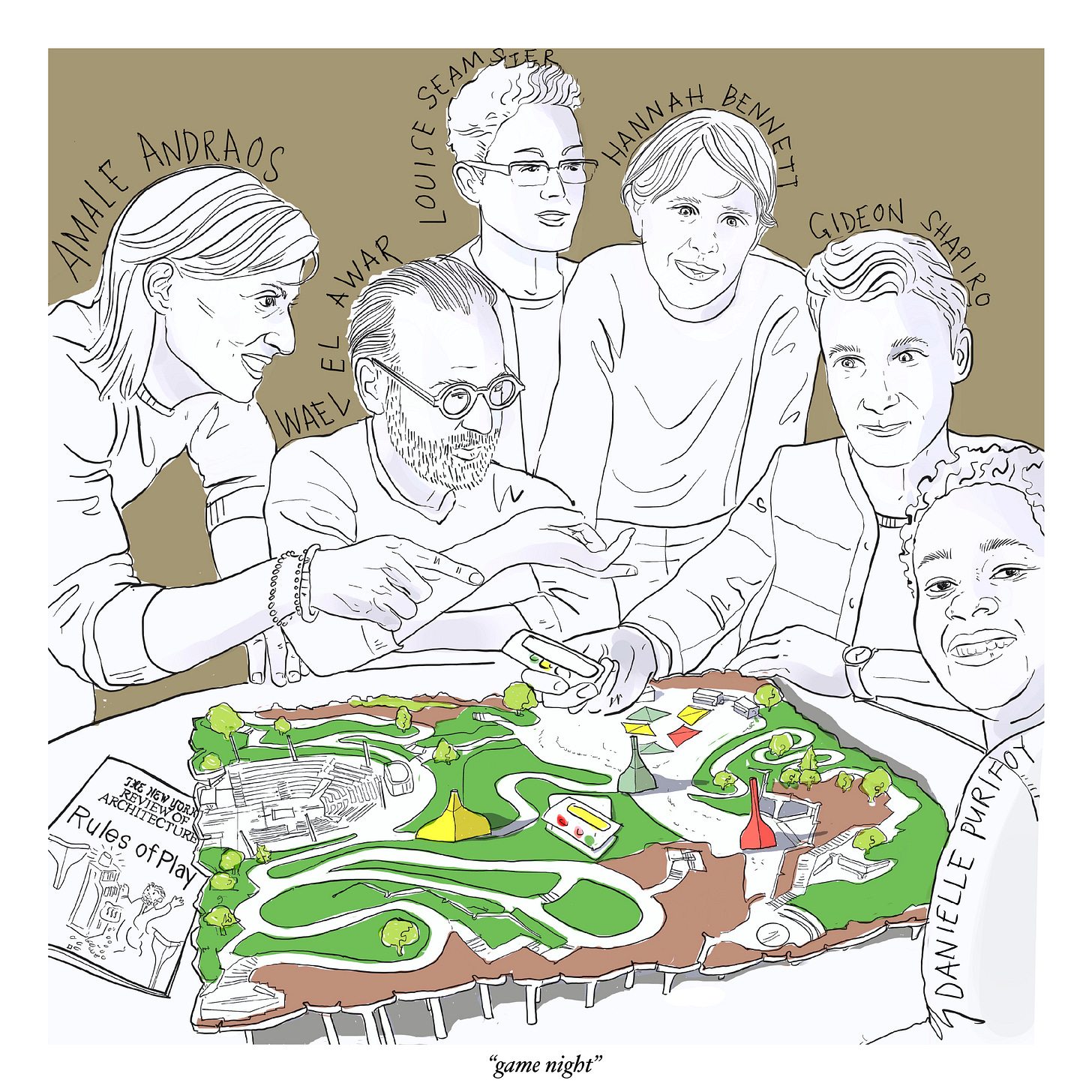S K Y L I N E | 22 | We have to see architecture as one component in a larger fight
DAP turns 1, The Return of FOMO, New York Collates Memes, Notes on Not for Construction, Lev Bratishenko and Miranda July talk family
Welcome! If someone forwarded you SKYLINE, sign up here to receive it weekly.
6/5: "We have to see architecture as one component in a larger fight,” said Colloqate design principal BRYAN LEE JR. at Design as Protest’s National Call last Saturday. Over the course of the two hour call, formatted as a zoom webinar with an open and energetic chat (and the occasional music break), more than a dozen different organizers methodically presented the accomplishments of the last year, ranging from their weekly event roundup to a newspaper to their Anti-Racist Design Justice Index to youth organizing. Architect TAYLOR HOLLOWAY suggested tactics have evolved since the letters and statements of last summer towards partnerships focused on follow-through: “We are both calling out, calling in, and helping out those who have made commitments,” to move “beyond statement culture.” That said, “DAP brings a bias towards action in all that we do,” emphasized architect KARIM HASSANEIN, citing DAP participation in protests and the speed with which they came to the aid of others, ranging from the Asian community to the Palestinians, and underlining that, “we are prepared to put our bodies on the line.” The end of the call laid out ways to become involved. “We are diverse AF” said designer and organizer DE NICHOLS - not to underline that the organization is complete, but rather to emphasize to potential newcomers that “there are many different ways to plug-in.” Concluded LEE, “It is a tremendous honor to work with everyone on this call - and we are just one year down, with a lifetime to go.”
There is a tension between our now firmly established ‘remote’ world and the physical ‘in-person’ universe that is once again open for business - but for some people actually quite remote. That’s right: we are about to see the return of FOMO.
It’s my birthday today (hello, 33!). To celebrate, I thought I would take my turn pulling together the last week for our readers, but as the conversation around the built environment moves off zoom and instagram and back into rooms and, well, buildings, our work at NYRA is about to become much more difficult. As events and conferences move back to venues, no longer will I be able to casually join a two hour DAP call on a Saturday afternoon while doing chores and looking after my daughter.
So over the next weeks, we have invited a bunch of guest editors to come help out, starting, next week, with TIFFANY XU, who also braved a Canadian Center for Architecture virtual seminar this week to write to you about ‘What, if not the family?’
See the bottom for events this week and find also dispatch from a83’s gallery opening, ‘Not for Construction,’ last Thursday, and (because the discourse is not off instagram just quite yet) our first ever memes-roundup.
- Nicolas Kemper
O! Speaking of in-person, we are officially back in bookstores - well, at least McNally Jackson.
DISPATCHES
6/2 – What, if not the family?
"We are living alone, unmarried, childless, or child-free if you prefer, and we are living for longer,” a chipper fictional news anchor announced at the Canadian Center for Architecture’s “What, if not the family?” virtual event on Wednesday. Entirely pre-recorded, the event’s guest contributions ranged from short self-filmed cameos: KUMIKO INUI described home as a space for calm, safety, and replenishment, and EMANUEL ADMASSU called for abolishing the “violent borders of the the nuclear family”—to research presentations: FRIDA ESCOBEDO spoke about global care chains and domestic workers, whose “caretaking involves a certain degree of bonding and even affection that is impossible to monetize and measure”—to more in-depth spatial design responses.
Consistent throughout the proposals was a tongue-in-cheek playfulness with format. ELENA SCHUTZ from Something Fantastic presented the firm’s Constellation House, a shiny gridded multifamily highrise with day rooms and night rooms. The project borrows of concepts from the automobile industry—screenshots the Wikipedia page for the “rebound effect,” and google image search results for “SUV large” flooded the screen. Other highlights included GRACE MORTLOCK and DAVID NEUTSTEIN from Sydney-based Other Architects, who proposed de-cladding light timber-frame McMansions to create more communally oriented suburban blocks. In London-based Edit Collective’s video, three women each operated vacuum nozzles connected to a single machine while a narrator from the future described the achievement of total collective care, ranging from corrupting single-user-ness of household appliances to how governments calculate GDP.
A pause from the architectural solutions came at the interview by CCA curator LEV BRATISHENKO with writer and filmmaker MIRANDA JULY. “I started saying that every family is a cult,” July said, and discussed current concerns in her work—the fixed premise of marriage, the absurdity of permanence, the intimacy afforded by strangers. July sees the contemporary home is not as a building but as a threshold between an inside and outside—”what I think of is shoes lined up at the door.”
- Tiffany Xu
6/3 - Not for Construction
Amidst the noise surrounding rendered spaces, augmented realities and NFTs, an exhibition of 13 architectural drawings, shown at SoHo’s a83 gallery, makes the case for the continued importance and relevance of hand-made images to the practice of architecture. “Architectural Drawing: Not for Construction” features work by four practicing architects—BRUNA CANEPA, SEAN CANTY, ADAM CHARLAP HYMAN, and CLEMENT LUK LAURENCIO— answering the question: “What does it mean to make architectural drawings if not for construction?” Or, can drawing a fictive architectural space be an end in and of itself in an industry demanding constant engagement with “the real”?
The 13 drawings, all neatly arranged along four striated walls, have an answer: yes. Sean Canty’s “Drawing Doubles” convolutes the gable’s quaint, recognizable form into abstraction, further estranged by the simultaneous worm’s and bird’s eye views in each. Laurencio’s “Spatial Fictions” follow the same rejection of rooted perspective. Here, Laurencio’s fondness for surrealist writer Jorges Luis Borges materializes in continuous shifts between section, plan, elevation, and isometric views in “Apartment #5, a Labyrinth and Repository of Spatial Memories, Diptych”; depictions of classical forms, like the arched entry and Doric column in “Memory Palace, Triptych”, are reminiscent of Italian architect Carlo Scarpa’s love of Venetian aesthetics, but muddled by melted boundaries and semi-omnipresent perspective.
Bruna Canepa’s “Mini Construction Sites” center the construction process—the typical purpose of any architectural drawing—within the act of making art itself: paper is the first and final object, the physicality of building translated into movement of the hand across the surface. Charlap Hyman’s work is the antithesis of Canepa’s; it is fitting that the two architects are opposite one another across the gallery. Here, four cut-paper images depict a small monument’s ruin; degradation and absence stand opposite of creation and presence.
To hand draw an impossible space within architectural practice today, with its relentless demands for digitalization, is a small act of rebellion. There is value in letting visions and reality stay in separate realms, flitting between the two is not just the architect’s prerogative but imperative. Hand drawing takes an intangible fantasy and turns it into something the architect brings back to the real world. Without this, you may as well just mint an NFT.
- Anna Gibertini
New York collates architecture memes…
For all those living under a rock, memes have become the dominant ‘discourse’ in architecture. Or, as the account @socially_condensed puts it:
For all of those without the time and emotional energy to wade through the hundreds of posts last week, we thought we would try highlighting a few standouts…
This pokes fun of this year’s American Pavilion, ‘American Framing’, whose own somewhat bizarre instagram account seems intent on poking fun at itself, but is not doing as good a job as DLW.
This one does not need any backstory.
And that’s a wrap!
Letters to the Editor
Back to Normal?
Always polite, the New York Times has been summarizing our mood thusly: "Bored, anxious, hopeful — all at once." This doesn't quite capture it. I can feel the dissatisfaction in the air — who wants things to return to how they were? Haven't we had a year now to see how awful it was, how OTHERWISE it can be? I'm looking forward to the Architecture Lobby's Architecture Beyond Capitalism Summer School. To learning how to skate in the no-skate zone of the all-concrete high school ad hoc public plaza across the street. (It's all we've got.) To reading whatever Mackenzie Wark writes. To listening to Simon Critchley convince me that I can read Heidegger (and that philosophy is a thing). To pondering the sage posts of Dank Lloyd Wright. To remember that environment matters, but that US TOGETHER matters more.
Matthew Allen
(To submit your own letter to the editor, click here.)
Events!
Monday, 6/7
Book Talk – Drama with Diana Budds, Bruce Mau, David Rockwell
1:00 PM, AIA New YorkThe Right to Infrastructure with Danielle Purifoy, Louise Seamster
6:30 PM, Columbia University GSAPP
Tuesday, 6/8
Living with Architecture as Art with Peter May, Maureen Cassidy-Geiger, Mark Ferguson
6:00 PM, ICAA
Wednesday, 6/9
MATHUR | DA CUNHA with Dilip da Cunha, Anuradha Mathur
11:30 AM, Columbia GSAPPWriting for Architects and Designers, Session 2: Activate your Prose with Gideon Shapiro
4:00 PM, AIA New YorkThe Post-COVID Future of Avery Library and Its Key Partnerships: Reimagining Learning and Research with Amale Andraos, Hannah Bennett, Ateya A Khorakiwala, Caitlyn Campbell, Charlette Caldwell
6:00 PM, Columbia GSAPP
Thursday, 6/10
Modes of Travel: (Un)Learning Education symposium with Alisha Morenike Fisher, Andrew Clancy, Annelys de Vet, Harriet Harriss, Piers Taylor, Neil Pinder, Neal Shasore
9:00 AM, The Architecture FringeCENTENNIAL IDEOLOGIES & ECOSYSTEMS: POTENTIAL FUTURES FOR LEBANON with Sandra Frem, Wael El Awar6/10 Thu, 12:00 PMColumbia GSAPP, GSAPP Collective for Beirut
Post-COVID Cities: Reinventing World Cities with Hélène Chartier, Lucy Bullivant, Vicente Guallart, Jeffrey Raven
12:00 PM, AIA New YorkSafe and Equitable Streets: Age, Ability, and Inclusion with Renia Ehrenfeucht, Aimi Hamraie, Jessica Murray, Ariel Ward, Claire Weisz
6:00 PM, AIA New York
Friday, 6/11
Fight or Flight? Climate Justice and Equity with Lauren Wang, Judah Asimov
9:00 AM, AIA New York
Four desk editors run NYRA: Alex Klimoski, Phillip Denny, Carolyn Bailey & Nicolas Kemper (who also serves as the publisher). They rotate duties each month.
If you want to pitch us an article or ask us a question, write us at: editor@nyra.nyc
For their support we would like to thank the Graham Foundation and our issue sponsors, Tod Williams Billie Tsien Architects, and Thomas Phifer.
If you want to support our contributors and receive the Review by post, subscribe here.









